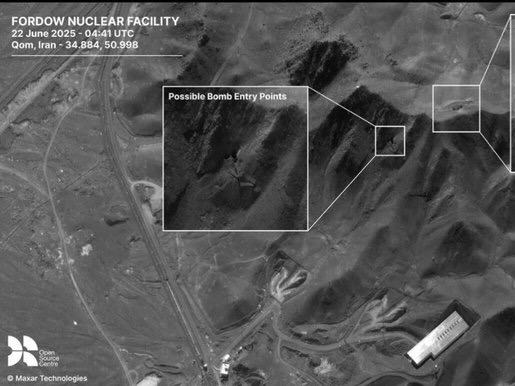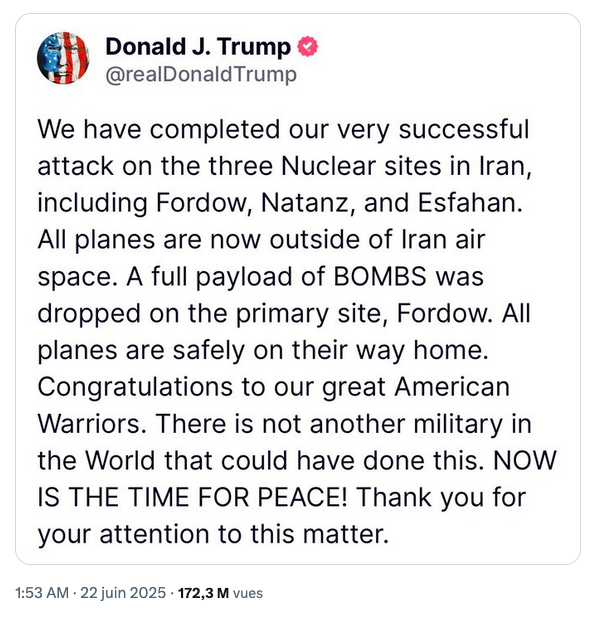The stakes of Iran’s nuclear program are not what one might think. Tehran renounced the atomic bomb in 1988, but is attempting, with Russia’s cooperation, to discover the secrets of nuclear fusion. If it succeeds, it would help the states of the South decolonize by freeing themselves from oil.
As for the stakes of the bombing of certain Iranian nuclear sites by the United States, they may also not be what one might think.
This affair is all the more opaque because it is not possible today to establish a clear distinction between research on civilian nuclear fusion and military fusion.
Since the fall of Iraq, under the blows of the British and the United States, London and Washington have popularized the myth of Iranian military nuclear power, in line with that of Iraqi weapons of mass destruction. This myth has been taken up by Israeli “revisionist Zionists” (not to be confused with “Zionists” tout court) and their leader, Benjamin Netanyahu. For twenty years, Westerners have been inundated with this propaganda and have ended up believing it, although announcing for such a long period that Tehran will have “the” bomb “next year” makes no sense.
However, even though Russia, China, and the United States all agree that Iran currently has no military program, everyone can see that Iran is doing something at its power plants. But what?
In 2005, Mahmoud Ahmadinejad was elected president of the Islamic Republic, replacing Sayyed Mohammad Khatami. He is a scientist whose vision is to free colonized peoples. He believes that by mastering the atom, he will enable all peoples to free themselves from Western oil transnationals.
Iran then developed training programs for nuclear scientists in numerous universities. The goal was not to create a small elite of a few hundred specialists, but to train battalions of engineers. Today, there are tens of thousands of them.
Iran intends to discover how to achieve nuclear fusion, whereas Westerners are content with fission. Fission is the splitting of an atom; while fusion is the joining of atoms, which releases an immeasurable amount of energy. Fission is used for our power plants, while, for the moment, fusion is only used for thermonuclear bombs. Mahmoud Ahmadinejad’s plan is to use it to generate electricity and share it with developing countries.
This knowledge is revolutionary, in the Khomeinist sense of the term, that is, it allows for an end to the dependence of the Southern states and their economic development. It clashes head-on with the British vision of colonialism, according to which His Majesty had to divide and rule and prevent the development of the colonized. We recall, for example, that London forbade Indians from spinning the cotton they grew themselves so that it could be spun by its Manchester mills. In response, Mahatma Gandhi set an example for his people and spun his own cotton, defying the British monarchy. Identical to this, Mahmoud Ahmadinejad’s project defies the power of the West and the Anglo-Saxon oil transnationals.
It is perfectly understandable to be concerned about Iranian investment in nuclear power because these technologies are, by definition, dual-use, both civilian and military. It is clear that this is not the usual civilian use, and the detailed discovery of fusion processes could also be used for military purposes. In any case, Iran is seeking an inexhaustible source of energy.
China and Russia have repeatedly stated that Iran has not had a military nuclear program since 1988. Unlike us, Russia knows what it is talking about: it is involved in Iran’s research. There are Russians in many Iranian nuclear facilities. It goes without saying that Moscow fears proliferation as much as we do. But, unlike us, not civilian nuclear power. Building on the work of Andrei Sakharov, Rosatom and the Russian Academy of Sciences are continuing research, particularly for the Tokamak project. China, South Korea, the United Kingdom, and France have their own research in this area.
It should also be remembered that Iran is a signatory to the Treaty on the Non-Proliferation of Nuclear Weapons (NPT). It is for this reason that it is subject to inspections by the International Atomic Energy Agency (IAEA). Since 1988, the IAEA has never found any evidence suggesting that Iran still has a military nuclear program. However, the Agency has asked numerous questions to clarify certain aspects of its civilian program and has not received any answers, which is perfectly understandable given the investment in Iranian-Russian fusion research. In practice, the documents released by the Iranian press two days before the Israeli attack attest that the director of the IAEA, the Argentinian Rafael Grossi, behaves like a spy in the service of Israel, to which he transmits all the information from its inspectors; this is even though Israel is not a signatory to the NPT and therefore not a member of the IAEA.
On 4 May 2010, Tehran submitted a proposal to the Conference of the Parties to the United Nations NPT for the “Establishment of a Nuclear Weapon-Free Zone in the Middle East” [ 1 ] . This proposal was welcomed by all the states in the region, with the exception of Israel. Indeed, Tel Aviv, which benefited from transfers of French technology from senior officials of the Fourth Republic, possesses the atomic bomb [ 2 ] .
Finally, if Washington does not intervene alongside Tel Aviv and use its penetrating bomb to try to destroy the Fordo plant, the Israel Defense Forces (IDF) could resort to the “Samson option” [ 3 ] , that is, the atomic destruction of Iran, even if they were to suffer a nuclear response. [ 4 ]
General Mohsen Rezaee, a senior officer in the Revolutionary Guard Corps and a member of Iran’s National Security Council, said in an interview on June 14 that “Pakistan has assured us that if Israel uses a nuclear bomb against Iran, it will also attack Israel with a nuclear bomb.” However, Pakistani Defense Minister Khwaja Asif did not confirm these statements. Without denying them, he simply said: “Israel has targeted Iran, Yemen, and Palestine. If Muslim countries do not unite now, everyone will suffer the same fate. We support Iran and will defend it in all international forums to protect its interests.”

It is not at all certain that the GBU-57 penetrator bombs would have been able to penetrate the underground base at Fordo. The base was dug under 80 meters of granite. To destroy it, several GBU-57s would have to be fired successively into the same hole.
Ultimately, the Trump administration believed, as White House spokeswoman Karoline Leavitt said: “Let’s be very clear, Iran has everything it needs to achieve a nuclear weapon. All they need is a decision from the Supreme Leader to that effect, and it would take them about two weeks to complete the production of that weapon.”
So, since the beginning of June, it has been secretly preparing “Operation Midnight Hammer ” at the instigation of General Michael Kurilla, commander of the United States forces in the Middle East (CentCom). To do this, the general met his Israeli counterparts on April 25 and gathered the most precise information on his targets. On June 10, he presented to the House of Representatives his strategic analysis of the opportunities that the upheavals in the Middle East offered to the United States. In passing, he revealed that he had presented President Trump with a wide range of options for exploiting them [ 5 ] .
On June 11, the State Department ordered all non-essential personnel and their families to withdraw from Bahrain, Qatar, and Iraq.
On June 16, President Donald Trump rushed out of the G7 summit in Kananaskis, Canada. On his plane back to Washington, he posted an angry post about his allies: “Because he’s looking for publicity, President Emmanuel Macron of France falsely stated that I left the G7 summit in Canada to return to Washington to work on a ‘ceasefire’ between Israel and Iran. This is false. He doesn’t know why I’m now on my way to Washington, but it certainly has nothing to do with a ceasefire. Much bigger than that. Whether deliberately or not, Emmanuel is always wrong. Stay tuned.” [ 6 ]
On the night of June 21-22, President Trump, in violation of the UN Charter, launched an attack on Iran’s main nuclear sites, but not on the Bushehr nuclear power plant, due to the presence of Russian personnel. However, it appears that Washington had warned Tehran in advance that it was going to strike: a column of trucks was seen by satellite evacuating equipment from the Fordo base.

This surprise attack can be interpreted in two ways: either President Trump saved Israel from massive destruction by Fatah-1 hypersonic missiles, or, conversely, he saved Iran from an Israeli nuclear bombardment. The fact that the Pentagon did not attack the Fatah-1 launchers, which are less well protected than civilian nuclear power plants, suggests the latter interpretation.
In any case, by destroying Iran’s nuclear research program, President Trump has deprived Israeli Prime Minister Benjamin Netanyahu of the argument he has been using for twenty years to wage his “war on seven fronts.”
We must remember that President Donald Trump, during his first term, ordered the assassination of ISIS Caliph Abu Bakr al-Baghdadi (October 27, 2019), followed by that of Iranian General Qassem Soleimani (January 3, 2020). In his mind, this was about striking the main Sunni military leader and the main Shiite military leader in order to bring their two groups into line. Which worked.
It is therefore possible that bad news awaits an Israeli leader in the coming months. The arrest of Benjamin Netanyahu by the Israeli justice system, for example.
—
[ 1 ] “ Creation of a nuclear-weapon-free zone in the Middle East ”, Voltaire Network , May 4, 2010.
[ 2 ] Israel and the Bomb. Secret History of Israeli Nuclear Power , by Avner Cohen, Demi-Lune (2020).
[ 3 ] The Culture of War , Martin van Creveld, Presido Press (2008).
[ 4 ] “ Is the possibility of a World War real? ”, by Serge Marchand & Thierry Meyssan, Voltaire Network , April 9, 2024.
[ 5 ] “ Full Committee Hearing: “US Military Posture and National Security Challenges AFRICOM + CENTCOM” ”, US House Armed Services Committee, YouTube , June 10, 2025.
[ 6 ] “ Donald Trump ”, Truth Social , June 17, 2025.



